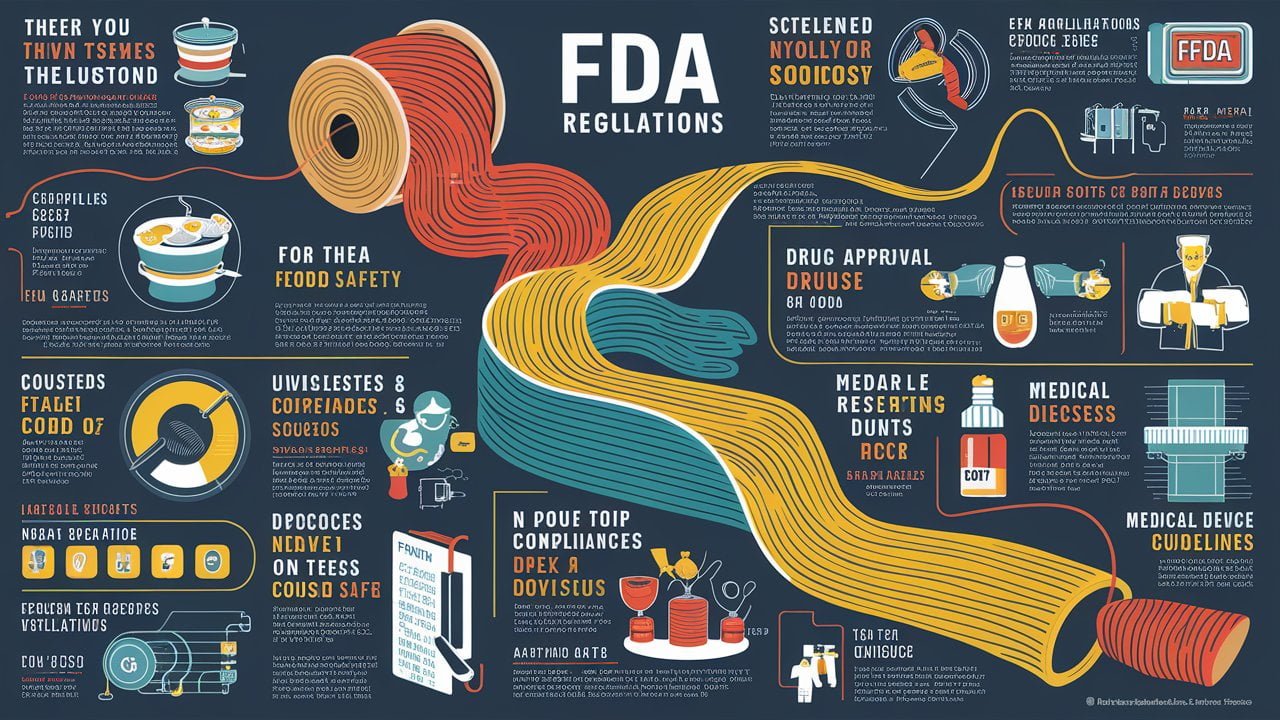Within the intricate landscape of regulatory compliance, the Food and Drug Administration (FDA) stands as a formidable guardian of public health and safety in the United States.
As the primary regulatory body overseeing various industries, including food, drugs, medical devices, biologics, and cosmetics, the FDA’s impact reverberates through every facet of healthcare and consumer product development.
Understanding the labyrinthine web of FDA regulations is not just a task for those directly involved in compliance or manufacturing but a fundamental requirement for maintaining impeccable standards in the healthcare sector.
Delve into the realm where meticulous adherence to FDA guidelines can spell success or setback; where nuances in compliance can determine patient safety or risk. To navigate this realm effectively requires not only knowledge but an unwavering commitment to upholding stringent standards set by the FDA.
Join us on an enlightening journey as we unravel the intricacies of FDA regulations – exploring their significance beyond mere legal frameworks to their profound influence on shaping healthcare practices and ensuring quality in products that touch millions of lives every day.
Prepare to embark on a comprehensive exploration that unveils the core principles underpinning this vital regulatory entity and delves deep into the implications it holds for industries striving for excellence amidst a sea of regulations.
Understanding FDA Regulations.
The Food and Drug Administration (FDA) plays a pivotal role in overseeing the safety and efficacy of a wide array of products that we encounter daily. From the food we eat to the drugs we take for various ailments, medical devices that aid in diagnostics and treatment, biologics like vaccines, and even cosmetics, the FDA has established stringent regulations to protect consumer health.
For instance, when it comes to novel drugs seeking approval for marketing in the United States, sponsors must submit detailed data from clinical trials demonstrating both safety and effectiveness. This thorough evaluation ensures that only scientifically proven medications reach patients, safeguarding them from unproven or potentially harmful treatments.
In the realm of medical devices such as pacemakers or diagnostic imaging equipment, the FDA’s oversight doesn’t stop at initial approval. It extends throughout the device’s lifecycle to monitor any adverse events reported by users or healthcare providers.
By requiring manufacturers to adhere to quality control standards outlined by the FDA, products on the market are less likely to malfunction or cause harm during use. These measures not only instill confidence in consumers but also contribute significantly to public health outcomes by reducing risks associated with substandard or unregulated products.
Moreover, FDA regulations serve as a crucial component in maintaining standards within industries where consumer well-being is paramount. Biologics like blood products require meticulous handling and testing criteria to prevent contamination or transmission of infectious diseases among recipients.
Cosmetics undergo scrutiny for ingredient safety and labeling accuracy to prevent allergic reactions or adverse effects on users’ skin. By upholding robust regulatory frameworks across diverse product categories, the FDA ensures that public health remains a top priority while fostering innovation within these sectors through structured pathways for product development and approval.
FDA Compliance Requirements.
Compliance with FDA regulations is paramount for companies operating in industries regulated by the agency. The FDA sets stringent standards to ensure the safety, efficacy, and quality of products available to consumers.
Different industries, such as pharmaceuticals, medical devices, food, and cosmetics, have specific compliance requirements tailored to their unique characteristics. For example, pharmaceutical companies must adhere to Good Manufacturing Practices (GMP) when producing drugs to maintain consistency and quality throughout the manufacturing process.
Navigating the intricate web of FDA regulations can be daunting for companies, especially those introducing new products or operating across multiple jurisdictions. Companies need to invest in robust regulatory affairs teams that stay abreast of changing guidelines and updates from the FDA.
Understanding the nuances of regulatory language and requirements is essential to avoid penalties or product recalls due to non-compliance issues. By conducting regular internal audits and seeking guidance from regulatory consultants when needed, companies can proactively address gaps in compliance before they escalate into major issues.
Thorough documentation and reporting play a crucial role in maintaining compliance with FDA standards. Proper record-keeping helps demonstrate a company’s adherence to regulations during inspections or audits by regulatory authorities.
For instance, medical device manufacturers must maintain Device Master Records (DMRs) containing detailed specifications and manufacturing procedures for each device. Implementing robust electronic document management systems can streamline documentation processes and ensure that all relevant information is easily accessible for compliance purposes.
By prioritizing accurate record-keeping practices, companies can position themselves favorably in terms of compliance with FDA regulations.
Impact on Healthcare Professionals.
Healthcare professionals play a pivotal role in ensuring patient well-being and safety, with FDA regulations significantly shaping their daily practice. From prescribing medications to using medical devices and ensuring the quality of products administered to patients, healthcare providers must adhere to FDA standards rigorously.
For example, pharmacists must comply with FDA regulations when dispensing drugs to patients, verifying that medications meet the necessary safety and efficacy requirements set by the agency.
Challenges arise for healthcare professionals as FDA rules continue to evolve in response to technological advancements and emerging health concerns. Being updated about these changes is crucial but can be daunting due to the volume of regulatory modifications introduced regularly.
Consequently, staying informed about new guidelines regarding drug interactions, updated warnings or contraindications, or revised dosing recommendations poses difficulties for physicians who must balance patient care with compliance obligations.
To navigate this complex regulatory landscape effectively, healthcare professionals can employ various strategies to enhance their understanding of FDA regulations. Attending training sessions, seminars, or conferences focusing on recent FDA updates can aid in staying current with changing guidelines.
Additionally, leveraging digital resources such as online portals provided by the FDA for practitioners can streamline access to critical information regarding drug approvals, recalls, or safety alerts. By proactively seeking knowledge and engaging in continuous education related to FDA regulations, healthcare professionals can optimize patient care outcomes while aligning with industry best practices.
Recent Updates and Changes.
Staying abreast of recent updates to FDA regulations is paramount for businesses and healthcare practices seeking to maintain compliance and ensure the safety of their products and services. One notable change that has reverberated across industries is the emphasis on digital health technologies.
The FDA has been increasingly focusing on regulating software applications used in healthcare, such as mobile medical apps and telemedicine platforms, to enhance patient care while safeguarding data privacy. Companies developing these technologies must navigate stringent guidelines to secure approvals, shifting the landscape of healthcare delivery towards a digital frontier.
Moreover, the FDA’s issuance of new policies regarding drug manufacturing has forced pharmaceutical companies to reevaluate their quality control processes. Recent directives emphasize the importance of adopting advanced analytics, automation, and real-time monitoring systems to mitigate risks and improve production efficiency.
These changes aim to enhance drug quality standards, ensuring consumer safety while streamlining manufacturing operations. As a result, pharmaceutical firms are investing heavily in technology upgrades and employee training to align with the evolving regulatory landscape set forth by the FDA.
Looking ahead, anticipated regulatory developments from the FDA suggest an increased focus on genetic testing services and personalized medicine. With advancements in genomic research shaping diagnostic tools and treatment strategies, the FDA is expected to introduce guidelines that address the unique challenges posed by these innovative approaches.
Healthcare providers offering genetic testing may face heightened scrutiny regarding data security protocols and informed consent practices. By proactively preparing for forthcoming regulatory shifts, businesses can strategically position themselves to leverage emerging trends in precision medicine while upholding ethical standards prescribed by the FDA.
In conclusion, adapting to recent updates and upcoming changes in FDA regulations demands proactive engagement from stakeholders across sectors.
By embracing technological advancements in compliance management systems, refining manufacturing processes for enhanced product quality assurance, and anticipating regulatory shifts in emerging fields like personalized medicine, organizations can fortify their foundations for sustained growth amidst evolving industry standards enforced by the FDA.
Keeping a vigilant eye on policy modifications allows businesses and healthcare entities alike to navigate complex regulatory landscapes with agility while fostering innovation within frameworks that prioritize public health outcomes.
Best Practices for Regulatory Compliance.
Implementing best practices is essential for organizations aiming to meet and exceed FDA regulatory requirements. One crucial strategy is the establishment of a robust quality management system (QMS) that aligns with FDA standards.
Companies can achieve this by documenting processes, ensuring data integrity, and conducting regular internal audits to identify potential areas of non-compliance. By meticulously following good manufacturing practices (GMP) and maintaining detailed records, businesses can enhance their compliance posture and streamline interactions with the FDA during inspections.
Maintaining a culture of compliance within companies requires ongoing training programs tailored to various organizational levels. From frontline staff to executive leadership, everyone should receive education on FDA regulations relevant to their roles.
Interactive training sessions can simulate real-world scenarios to empower employees with practical knowledge on handling compliance challenges effectively. Furthermore, conducting periodic audits not only helps affirm adherence but also provides valuable insights for continuous improvement in regulatory processes.
Proactively addressing potential non-compliance issues before they escalate is paramount in safeguarding against costly penalties or product recalls. Utilizing risk management tools such as Failure Modes and Effects Analysis (FMEA) enables organizations to identify vulnerabilities in their processes and products systematically.
By fostering a culture that encourages reporting of near-misses or deviations from protocols, companies can swiftly address issues before they snowball into significant compliance breaches. Additionally, regularly reviewing and updating standard operating procedures based on emerging trends or FDA guidance ensures preemptive measures are in place.
In conclusion, by adopting these best practices – including building a strong QMS, providing targeted training, performing regular audits, employing risk management techniques, and promoting a culture of transparency – organizations can not only navigate complex FDA regulations efficiently but also elevate their overall quality standards.
Proactive compliance efforts not only mitigate risks but also foster trust among stakeholders by demonstrating a commitment to upholding safety and efficacy standards mandated by the FDA.
Conclusion.
In conclusion, a comprehensive understanding of FDA regulations is paramount for regulators, compliance officers, and healthcare professionals to navigate the intricacies of ensuring public health and safety through regulatory compliance.
By unraveling the complex web of FDA regulations surrounding food, drugs, medical devices, biologics, and cosmetics, stakeholders can better grasp the stringent requirements set forth by the agency. Adherence to these regulations not only safeguards patients and consumers but also elevates industry standards to uphold quality and efficacy in healthcare products.
As industries evolve and technologies advance, staying abreast of the ever-changing landscape of FDA guidelines becomes imperative for organizations and practitioners alike. The proactive adoption of best practices, strict adherence to compliance requirements, and a commitment to ongoing education are vital components in fostering a culture of regulatory excellence.
By striving for continuous improvement and vigilance in monitoring regulatory updates, stakeholders can fortify their operations against non-compliance risks while promoting innovation within the confines of FDA standards.
Ultimately, a harmonious relationship between regulatory entities like the FDA and those subject to its oversight ensures that advancements in healthcare remain synonymous with safety, efficacy, and public trust.



